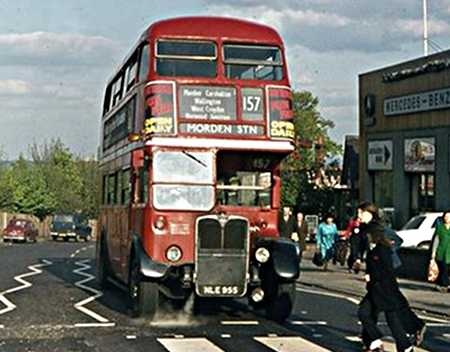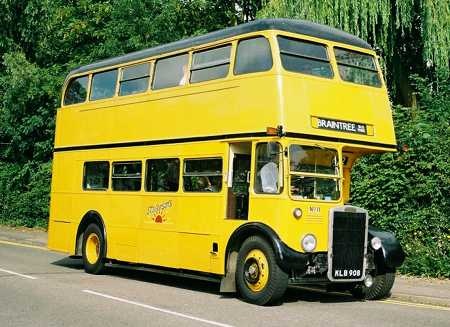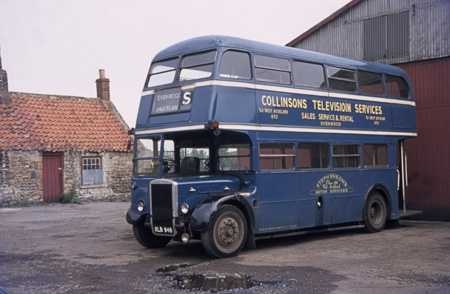London Transport – AEC Regent III RT – OLD 564 – RT4777
London Transport
1954
AEC Regent III RT – RT8/2
Weymann (Originally) Park Royal (Now) H56R
Here we have two views of the same vehicle in the two liveries of London Transport. The view of it in red is at Heathrow Bus Station on 21 January 1976, where she is on the 140 to Mill Hill East Station. The view in green shows her – as preserved – on Itchen Bridge in Southampton. It’s 6th May 1979, and she is addressed to Hemel Hempstead Bus Station on the 347 while taking part in the Southampton City Transport Centenary rally. According to BBF 12 London Transport book it was delivered new in the green livery.
Photograph and Copy contributed by Pete Davies
04/11/12 – 15:27
Evidence seems to say 1954, which I am inclined to take as date of entry into service. Are you sure it still has a Weymann body? It carried one when it was new, unquestionably, but it would have had at least one body swap while with LT and recent references quote Park Royal bodywork. Unfortunately the ultimate authority on this subject (Ian’s Bus Stop, on the net) currently has RT histories up to RT4199 only.
David Call
04/11/12 – 17:09
David,
The 2012 PSV Circle listing of preserved buses gives her as having Park Royal body, and new date of 7/54. Thank you for clarifying.
Pete Davies
04/11/12 – 17:09
I have corrected the information above, I supplied the information under the photo I just put the original body not having any information to dispute it, I had to start somewhere.
Peter
05/11/12 – 13:07
Strangely enough, the sound of the AEC 9.6 litre with pre-selector gearbox – one of the most common, homely and comforting sounds of the 1950s bus scene, is one that we don’t have on the Old Bus Sounds page. There are one or two on YouTube, but I have yet to find a really good one. They all seem a bit "rasping" and you don’t get the full flavour of the contralto in first and second, and then the rich deep tenor in third. Any offers?
Stephen Ford
05/11/12 – 15:20
I wonder just how much money was wasted by LPTB/LTE continually painting vehicles red, then green, merely because it was wanted in the other half of the business. I never got the impression that there was anyone controlling spare green/red ones as a sensible alternative.
I wonder if the vehicle in the top photo was ‘snapped’ because of the sloppy blind display – a side blind in the intermediate box – why?
And, Stephen, I recall the different sound of the ‘pre-war’ RT’s engines, until they changed the cylinder heads and they all sounded the same then.
Chris Hebbron
05/11/12 – 15:34
Thank you Pete for posting the photos of this RT. I have happy memories of learning to handle this type on the LT skid pan at Chiswick (even though I was already holding a PSV licence from the Eastern Traffic Authority) and I had to retake my test to satisfy LT. Once posted to New Cross garage, I was put on route 192 Lewisham Odeon to Plumstead, and had to contend with Shooters Hill, often boiling at the top when heavily laden, then a very sharp left turn into Eglinton Rd/Hill, which necessitated difficult low speed gear selection.
Norman Long
05/11/12 – 16:01
In answer to the question from Chris, I ‘snapped’ this one because I was at Heathrow to get some photographs of the entry into service of Concorde. While there, I took photos of some of the activity around the bus station, the others being FAR too modern to appear on this site! Certainly, the arrangement of the blinds could be better, but that isn’t why I took the photo.
Pete Davies
05/11/12 – 16:02
Chris, it’s interesting that you should say that. I didn’t know the pre-war RTs. Being from Nottingham I was rarely in London, but NCT had lots of pre and post war Regents in the early 50s, and most of the pre-war survivors were pre-selector. It has long been my recollection that the sound of these pre-war buses was subtly "the-same-but-different" from the "new" (!) 1948 (Metro-Cammell)/49(Roberts)/53 (Park Royal) Regent IIIs. When we moved to Barton territory in 1954, they had a considerable number of pre-war ex-Leeds Regents, which also had the "old" sound.
Stephen Ford
05/11/12 – 17:16
The pre-war RT engines, Stephen, were greatly influenced by Leyland engines in the STD and TF classes. Although Ricardo had a hand in designing the cylinder heads, the direct-injection engines had pot-cavity piston tops (like flowerpots,)a Leyland design, produced under licence, although this fact was kept under wraps! So the AEC engines were, to some extent, hybrids.
If you’ve experienced ‘boiling up’, Norman, this photo will bring back memories, at the top of Annerley Hill, near Crystal Palace, blinds turned for the return journey. This route passed the end of my road, although the vehicle shown is on a short working, not going through to Raynes Park.
Chris Hebbron
06/11/12 – 13:22
Ah, the 157 route, Chris. This, together with the 154, was the replacement for the 654 trolleybus route which ran between Crystal Palace and Sutton Green, the last day of trolleybus operation being 3 March 1959. I went to school at Selhurst, and our playing fields were on the other side of Croydon at Waddon. We had to use the 654, and later the 154/7 to get there. Anerley Hill was at the other end of these routes, beyond Norwood Junction. Whereas the trolleys ascended Anerley Hill in a steady manner, the replacement RTs always struggled up this gradient. LT derated the engine of the RT to 115 bhp, about the same as a K version Gardner 6LW, but the AEC lacked the low speed torque characteristics of the Gardner. However, the RTL, with its similarly derated engine was decidedly worse on hills than the RT.
Your point about the profligacy of the old LTE is very true. It was a huge, complacent, inward looking, arrogant organisation that steadfastly refused to acknowledge that it didn’t already know everything about bus operation and ancillary activities. Other participants in the bus industry – BET, BTC, municipals et al – were loftily referred to as "foreign operators". Insulated from comparisons with practices elsewhere in the industry, LTE had no yardstick by which it could assess its woeful standard of efficiency. Certainly, trade union power was very strong, but much more could have been done to improve matters.
Roger Cox
06/11/12 – 14:04
Thanks Chris—a great picture…I can almost recall the smell of the steam. Those were the days..the best job I ever had!
Norman Long
07/11/12 – 06:52
Wimbledon Hill was the challenge for the ‘pre-war RT’s, on route 93, from Putney Bridge to Epsom (Dorking on Sundays).
When I lived in Morden, Roger, it always seemed strange to me that no bus route went to Crystal Palace. The 157 went to Wallington (some cut short at Carshalton) and it was with some pleasure that I noticed that eventually one route, a least, ventured into South-East London.
My abiding memory of pre-war RT’s, in their after-life, was seeing a couple of them with Smith’s of Reading, around 1960, looking impeccable, despite their 20-odd years in service by that time.
Chris Hebbron
07/11/12 – 16:50
Another testing route for the RT was the 234 between Hackbridge and Selsdon. The Hackbridge section as far as Purley was straightforward enough, but from Purley the route climbed up the side of the Caterham Valley, then dropped down again through Riddlesdown before ascending again to Sanderstead Church on its way to Selsdon. Later, from March 1971 to January 1973, this route (together with XA Atlanteans) became the province of the solitary FRM, and, as my mother then lived at Riddlesdown, I frequently rode on this splendid machine when visiting. The FRM proved a highly competent performer, taking the gradients in truly fine style. What might have been……!
Roger Cox
07/11/12 – 17:32
One of the favoured few, eh, Roger? Another tragedy, as you say. along with the TSR2 and the recent Nimrod debacle!
Chris Hebbron
13/11/12 – 06:55
When the red RTs were repainted green and transferred to country area garages (and vice versa), does anyone know if the rear axles were changed at the same time? As far as I am aware, central area RTs had rear axles with a lower diff ratio than the ones operated on country routes. This gave the red RTs a lower top speed, but improved acceleration between stops, whereas the green RTs benefitted from a higher top speed, as befitting their routes, but progress through the gears would have been more stately. If such vehicles were simply repainted, it must have caused some confusion and frustration among drivers as they tried to keep to schedule with the ‘wrong’ type of bus!
Brendan Smith
13/11/12 – 12:59
I am surmising, Brendan, but I assume that the repainting exercise formed part of the Aldenham overhaul system. As you know, buses going in had their bodies and chassis separated and sent down dedicated overhaul tracks. Such was the scale of the disassembly process, the vehicle emerging at the far end with the registration OLD 564 would almost certainly have had a different chassis and body to the one that went in. Thus, the "new" OLD 564 might well have had a chassis that entered Aldenham as a high geared Country Dept vehicle. Alternatively, the appropriate higher geared rear axle would have been fitted during the overhaul process, and the emerging chassis would have acquired a green painted body. I worked for the LTE Country Bus Dept in a clerical capacity at Reigate in the early 1960s when the psv speed limit was raised to 40 mph, and all buses had the back axles converted appropriately. I cannot recall any "maverick" low geared machines being used on Country Area services after the conversion program was completed, and, in an organisation so besotted with standardisation as the old LTE, I doubt that such an eventuality would have arisen. If one did slip through the net, it would have been sorted out pretty quickly. Had it not been so dealt with, a T&GWU Union Complaint would certainly have been despatched hot foot to the relevant management in-tray.
Roger Cox
13/11/12 – 14:33
From what you’re saying, Roger, I’m assuming that the bodies never actually changed colour, they just ended up on a different chassis. I don’t know about the RT’s, but as well as different gearing, the Routemasters ‘or the RMC versions anyway’ also had a much higher interior spec with better upholstery and coach style overhead luggage racks
Ronnie Hoye
14/11/12 – 07:14
That might well be true, Ronnie. It would surely be very much easier and less costly to repaint a body in the same colour as before, but, with London Transport’s penchant for profligacy, one cannot be certain that logic prevailed. The only way to ascertain the facts would be by obtaining a history of the relevant body numbers. Unfortunately, Ian’s Bus Stop website, so often a valuable source of detail, does not have the histories of the later examples of the RT class, but one appreciates the magnitude of such a task.
Roger Cox
14/11/12 – 07:14
Thanks for the info Roger. The RTs are certainly a more fascinating breed than their standardised image would have us believe. I admit to having a real soft spot for them, as being brought up as a child in Airedale, they were in abundance on shopping trips to Bradford with Mum and Dad. Samuel Ledgard had a sizeable fleet of RTs (and some RTLs) in their classic blue and light grey livery, and Bradford CT also had twenty-five, the attractive livery of blue with cream window surrounds suiting them very well. The original livery applied to the RTs by BCT was fortunately short-lived, this consisting of all over blue, relieved by a cream band above the lower deck windows – in effect a blue version of LT livery. What was the transport department thinking of? Presumably the General Manager was on holiday for a fortnight when someone came up with that wheeze! As a youngster, I found the huge rear window on each deck of the RT so handsomely modern, and was captivated by the sound effects. The gently ‘knocking’ tickover of that quietly powerful 9.6 litre engine, the melodic pre-selector transmission, and the ‘chiff’ of the air brakes. Even the air-operated gearchange pedal made a noise. Wonderful!
Brendan Smith
14/11/12 – 10:30
You certainly live and learn when you read this site. As Brendan has pointed out, there’s a lot more to RTs than initially meets the eye. However, the discussion about rear axles leads me to ask which ones were fitted to Ledgard’s RTs. On the face of it, it would seem the country higher axle would have been a more suitable choice. Is this correct?
Roy Burke
14/11/12 – 14:05
I share every aspect of Brendan’s delight in having "known" the wonderful RTs, not only in this area but in their home territory as I had many relations in London and visited often.
I must tell here a very sad but unfortunately true anecdote reflecting the total lack of interest and knowledge in the job by a huge proportion of drivers and conductors – mind you, understandable I suppose as most likely very few mill or factory workers spent their leisure hour drooling over a certain loom or lathe !!
Now then back to Otley and Samuel Ledgard in 1963, and of course the last of the famous Sutton Depot "HGF" Daimler CWA6s (another fabulous family) had only just gone. I can remember making my way to the depot to start a late turn when, outside Woolworth’s in Kirkgate, I encountered one of our more cynical and constantly grumpy colleagues and was informed "Wait till you get to the garage – some more London garbage (polite word after editing) just arrived." Well, its a wonder I wasn’t knocked down as I sped to the depot knowing full well what to expect, although there had been no announcements or rumours about such an acquisition. There on the forecourt, gurgling away contentedly, was RT 4611 NXP 864, still advertising all the delights of the West End. It was the first RT to enter service from Otley depot and was fairly promptly prepared in what was to become the standard treatment for the 34 RTs and 5 RTLs we were to enjoy eventually. The roof route number box was very professionally removed and the front destination display repanelled to show only our new standard (by then) rolls, and over the platform the glass was neatly masked to leave only the right area for the same version. the rear destination displays were totally removed, and professionally panelled so that no trace remained. Preparation for painting was to the usual incredibly high standard of which Arthur and Benny were very justifiably proud.
Moving on now to a Saturday afternoon, late turn again, and "864" was parked in the garage, taxed all ready for the fray but probably not until Monday morning. My conductor was Eddy Busfield, who had been a University student on Summer part time employment but had "caught the enthusiast bug" and had stayed full time. We couldn’t resist after tea and approached the amenable shift garage man with "Can we PLEASE take the RT out ??" Being himself an Ex Pat Londoner he agreed at once, and so off we went like a couple of delighted infants :-
2010 Otley – Leeds
2055 Leeds – Otley
2150 Otley – Leeds
2235 Leeds – Otley
Refuel of course on the "wrong" side but who cared – a bit of awkward manipulation was a small price to pay for a wonderful evening. The proof of the pudding is in the eating, as the saying goes, and as more RTs arrived there were rarely if ever any more derogatory comments from those who "open their mouths before they put their brains in gear."
The RTs were rightly legendary and I also loved the RTLs with their different characteristics – wonderful tick over "wobbling" and Leyland "gargling."
Chris Youhill
14/11/12 – 14:14
Elsewhere on this site, under an item dealing with the Ledgard RTs, Chris Youhill states that one of these machines LYR 915, is now preserved in its original Country Bus Dept livery. Let us know, Chris – were the others green on arrival at Ledgard’s?
Roger Cox
14/11/12 – 15:32
I can remember six operators in the area who had RT’s. Service coaches and Bedlington District, both based in Ashington, had them for miners services and as a result they tended not to be of the best of condition appearance wise. Moor Dale who used them for contract and school runs, they stayed in LT red, but the mudguards and cream centre band were painted blue, Armstrongs of Westerhope ‘who were taken over by T&W PTE and became Armstrong Galley’ they were a pale green colour, Lockeys of West Auckland. they were black and white, but best of all were OK of Bishop Auckland, the RT’s looked wonderful in their livery.
Ronnie Hoye
14/11/12 – 16:30
In another of his evocative posts, above Chris Y briefly mentions the ‘HGF’ Daimler CWA’s at Sutton Garage. I’ve mentioned LTE’s profligate ways before, but when time came for the ‘D’s to go, Merton’s were replace by RT’s, but Sutton’s were replaced by RTL’s. This, of course, required driver and fitter re-training and new workshop material. tooling, manuals etc. Just five months later, the RTL’s were replaced by RT’s! Unbelievable!
My experience of the removal of the roof routebox on the generic RT class, was that it was usually done very badly, with pop rivets to the fore etc. SL did do a professional job, as Chris Y says.
Chris Hebbron
15/11/12 – 11:21
Roger, I’m not sure if any records were kept by enthusiasts as to what colour each RT was on arrival here, but certainly there was a mixture with plenty of both red and green. RT 4611, NXP 864, was definitely red as I saw in my delighted, nay rapturous, initial sighting mentioned above.
Chris H, I’m astonished, well not really I suppose, to read your fascinating account of the Sutton RTL/RT farce. Although I was always a very great admirer of London Transport it has to be said that they were far too rigid in practices and habits in many ways.
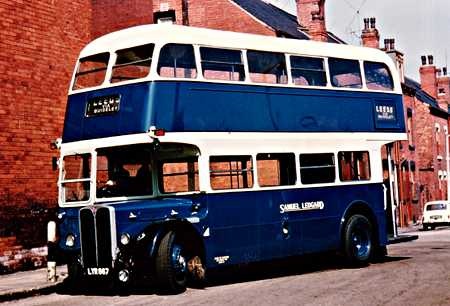
Photograph by ‘unknown’ if you took this photo please go to the copyright page.
This picture shows an immaculate newly prepared LYR 867 leaving the roof top park of Armley depot in a manner which could have seen the driver at the Labour Exchange (Job Centre to our younger friends) as a notice on the inner wall warned "ANY DRIVER LEAVING THE ROOF IN ONE SWEEP WILL BE DEALT WITH." Unusually the rear wheels are visible and painted blue – the normal practice was for the wheel discs to be fitted. The high standard of painting and preparation can be seen, as can the almost imperceptible removal of the roof route number box.
Chris Youhill
15/11/12 – 17:01
I presume, Ronnie, that when you refer to ‘RTs’ you mean any of the RT ‘family’, i.e. RT/RTL/RTW. I’m pretty sure that OK didn’t have any RTs as such, they acquired eight RTLs (I think) when the first batch were released c1958, inherited a further two with the business of Anderson (Blue Belle) of Evenwood, and bought a single RTW in the mid-1960s. Lockey’s (one of my favourite operators) had one RT and two RTLs.
David Call
15/11/12 – 17:45
Stephenson’s of High Etherley certainly had an RTW and possibly an RTL.
John Stringer
16/11/12 – 07:28
That really is a superb photo, Chris Y and does the RT proud. SL’s livery well-suited these vehicles. I like the thought of the driver cocking a snoot at authority and to heck with the consequences! Maybe the RT’s had a better steering lock than other vehicles. Is that true?
Chris Hebbron
16/11/12 – 07:29
Stephenson’s had at least two RTLs, these were replaced by two RTWs in the mid-1960s, these then remained with Stephenson’s until its shares in a couple of stage services were sold to OK (c1970?) – the RTWs were not included in the deal, these were sold by Stephenson’s. I can’t remember what happened to the single-deck service bus – an AEC Reliance, I think.
David Call
16/11/12 – 11:14
One of Stephenson’s RTWs has been preserved in Stephenson’s livery and condition. During 2006 it spent some time at Ensigns – I think they might have been doing some work on it for the owner – and having a Class VI ticket was used on that year’s heritage services in Essex, seen here in Old Harlow on route 622.
Michael Wadman
16/11/12 – 14:42
Yes, David, RT type rather than RT. As a youngster I seldom ventured South of the Tyne, so the only time I actually saw any of OK’s buses was when they were used on the Bishop Auckland/Newcastle service, or, as often happened during the summer, they descended on mass to the coast at Whitley Bay carrying hoards of Children on working mens club outings, but that’s no excuse for poor research on my part. In my defence, I can remember that some of the Bedlington District RT’s were MXX registrations and had roof box indicators, and the Moor Dale pair had Leyland radiators and were KGU 60 and LUC 355 – presumably RTL’s, sorry but I don’t know how many or what type were used by Armstrong’s of Westerhope, but they did have at least one of the breed.
Ronnie Hoye
17/11/12 – 07:01
I think a bit of confusion has crept in here. The Stephenson Brothers which John Stringer refers to was the operator in the Bishop Auckland area who sold their services to OK in 1970. They had a couple of RTL’s and an RTW and used a blue livery.
The yellow and black RTW was owned by STEVENSONS of Uttoxeter, Staffs. They ultimately sold out to Arriva and curiously, many Arriva Midlands vehicles still carry legal lettering which states; Stevensons of Uttoxeter t/a Arriva!
Chris Barker
17/11/12 – 07:02
Stevenson’s (with the yellow livery) were based at Spath, just outside Uttoxeter – a very old-established operator running services mainly in the Uttoxeter/Burton area. They eventually sold out to Arriva (or, perhaps, one of its predecessors, I’m not sure now), c1992. One notable event in its history was the takeover (in the run-up to bus deregulation) of the services of East Staffordshire District Council (previously Burton-on-Trent Corporation). Like Stephenson’s, they ran both RTLs and RTWs (more of the former, I think).
There is a page on Stevenson’s on this very website.
David Call
18/11/12 – 12:16
In reply to Chris H’s question about steering lock on the RTs I’m afraid I’ve really no idea. I suppose it is indeed possible but on balance I wouldn’t have thought too likely – so probably another thing we shall never know. Likewise, I never got to the bottom of the thinking behind that sinister notice inside the Armley Depot rooftop wall. I never worked from there, other than one morning taking my PSV test from within the main premises, as I was always at Otley garage and its nearby Ilkley "sub depot." I can only imagine that if a bus was parked in the front corner near the gateway an exit in "one sweep" would put the vehicle right up to the far pavement in the residential street outside, as in this picture. The Depot has long since disappeared under a major new road most reverently named "LEDGARD WAY" but the houses still remain, sadly in a most reprehensible state due to resident neglect, but that’s a social matter not for further comment here.
Chris Youhill
24/11/12 – 14:21
Oh, dear, sorry about that: getting my Stephenson’s and Stevenson’s mixed up. I really ought to know better than to venture into that strange land north of Watford of which I know little……
Michael Wadman
02/12/12 – 14:10
Here is Stephenson’s of High Etherley, Co. Durham KLB 948. New to London Transport as their RTW 218 in 1/50 and withdrawn by them in 4/65, it passed to Stephenson’s via the dealer Bird’s of Stratford upon Avon. I photographed it on a tour of Co. Durham independents in late Summer, 1969.
Note the mis-spelled advert !
John Stringer
03/12/12 – 14:04
It’s amazing how obvious that extra six inches on RTW’s was, compared with 7′ 6" wide RTL’s. Internally, it gave an extra 4" in the aisle and they put a 1" spacer between seat end and bus side for extra shoulder room. You seem, John, to be cursed in the same way as me, the ability to spot a spelling error, instantly, at 100yds (almost literally in this case!).
Chris Hebbron
01/04/13 – 12:51
Just as a matter of interest; the reason the top pic on route 140 has an old blind at the front is because by 1976 the writing was on the wall for RTs and LT stopped making specific blinds for them. So garages started using any thing RT to hand then RM blinds if available. If you look at pics from the seventies you see them starting to creep in. Standards were starting to drop by then.
Danny Robins
01/04/13 – 16:28
The 140 blind is not necessarily an old one. It is actually one from the rear blind box/the nearside rear above the platform. These had the numeral above the via points and were able to fit in the front via blind box of RTs.
As you say, such scenes would never have been countenanced during the heyday of RTs, when almost everything was correct. But towards the end, a wrongly sized blind showing the right information, was better than, No blind at all.
Petras409
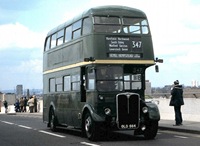 Vehicle reminder shot for this posting
Vehicle reminder shot for this posting
07/01/15 – 09:40
The caption/text to this bus gives 1954 as entry into service. According Ken Blacker’s book RT – Story Of A London Bus, this vehicle did not enter service until June 1959, when it was delivered in green livery to Epping (EP) bus garage, some 5 years later.
Paddy John
08/01/15 – 15:24
A significant number of later RTs delivered in 1954 were not needed for service immediately, and were put into store. This was in spite of LT selling off many non-standard types and utilities in this period, such as the 65 post-war STDs to Yugoslavia, amongst others. Presumably increased traffic needs or other withdrawals of older stock (pre-war RTs to the training school?) allowed their preparation for licensing and service. There are probably lists somewhere of the RT’s which were stored for this five-year period.
Michael Hampton
Quick links to the - Comments Page - Contact Page - Home Page
Comments - Please note: The comments facility is not currently available. Please see the home page for updates.
Please Note if you want to send a photograph with your comment please use the Contact Page by clicking here or send as an attachment via email.


